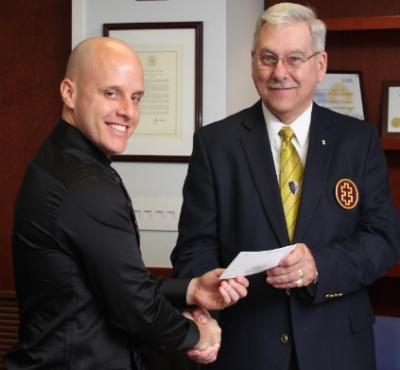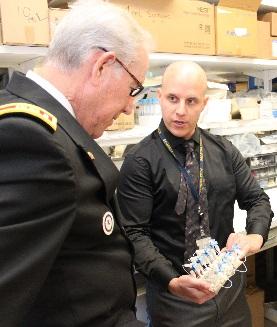
James W. Gollady, Jr., Right Eminent Department Commander (right), presents Hotaling with a check from the Knights Templar Eye Foundation. “I think this award is extremely important to pave a pathway for me in medical research,” said Hotaling. (Joe Balintfy, NEI)
NEI research fellow Nathan Hotaling, PhD, has been awarded a $65,000 grant from the Knights Templar Eye Foundation to develop a stem cell-based system to study Best disease, a genetic disorder that can cause progressive vision loss. The system will allow researchers to develop tests to monitor cellular changes that lead to Best disease, which typically starts in childhood.
“This grant will allow Dr. Hotaling to better understand the underlying basis for Best disease using stem cells,” said NEI Scientific Director, Sheldon Miller, Ph.D. “This funding is a good example of how partnerships and cooperation are helping move forward medical research to benefit the American public.”
Best disease, also known as vitelliform macular dystrophy, affects the retina, the light-sensitive tissue that lines the back of the eye. Specifically, Best disease disrupts cells in a small area near the center of the retina called the macula. The macula is responsible for sharp central vision, which is needed for detailed tasks such as reading, driving, and recognizing faces.
Hotaling’s research will take skin cells of Best disease patients and turn them into stem cells. The stem cells will be coaxed into becoming endothelial cells, which make up the small blood vessels in the retina, and the retinal pigment epithelium (RPE), a single layer of cells lining the back of the retina. These endothelial cells and RPE will in turn be put into a microfluidic system. Microfluidic devices are smaller than a quarter and have multiple channels that are capable of mimicking the structure and processes of human tissue.
“Currently there isn’t a good way to analyze Best disease outside the body,” said Hotaling. “The understanding and knowledge we anticipate from this disease model system may lead to tests for potential therapies, and ultimately a possible cure for Best disease.”
Representatives of the foundation noted that another goal of the funding is to help build momentum for early-career researchers.
“The foundation has sponsored a lot of good work over the years,” commented Arthur F. Hebbeler III, Grand Commander of the Maryland Knights Templar. “This grant will hopefully spur recognition for Dr. Hotaling, and greater grants down the road.”

“This is a moment of tremendous pride for the Institute”—NEI Deputy Director Belinda Seto.
From left to right: Seto, Miller, Gollady, Hotaling, Kapil Bharti, Chuck Warns, Brian Brooks,
and Hebbeler. (Joe Balintfy, NEI)

Hotaling at work in the Bharti Lab, NEI Unit on Ocular Stem Cells
and Translational Research. (Joe Balintfy, NEI)

“My research is about developing systems to model diseases outside the body.”
—Hotaling (third from left). (Joe Balintfy, NEI)

Hotaling (right), explains his Best disease model system, basically a tiny scaffold
that mimics conditions in the eye, to Knights Templar Eye Foundation Chairman
Chuck Warns. (Joe Balintfy, NEI)